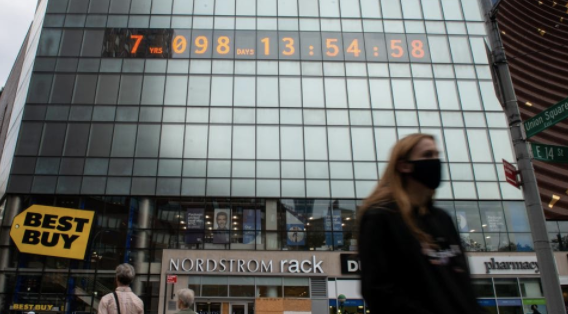“7 YRS 098 DAYS 13:54:58”
The neon red digits of the massive clock in Union Square, New York, is a clear reminder that the earth is in danger and that humans need to reduce emissions of carbon dioxide, a greenhouse gas that traps heat in the atmosphere. Otherwise, the global surface temperature may increase 1.5 degrees Celsius — which would be a global catastrophe causing sea level rise, extreme weather and loss of many species.
This digital countdown clock was inspired by the Carbon Clock, created by Mercator Institute on Global Commons and Climate Change (MCC). The Carbon Clock gives a countdown of the carbon dioxide emission budget — a simplified way to calculate the additional emissions that can enter the atmosphere before an increase of 1.5 degrees Celsius in global temperature. But unlike the Carbon Clock that runs on its website, the New York climate catastrophe clock is exhibited publicly in one of the busiest locations in the country, serving as a constant reminder for society of the urgency of climate change.
The clock is an effective method to pressure the public for immediate effort on mitigating climate change. Even though it does not show all of the aspects of climate change — the long-lasting impacts of rising global temperature, the science behind climate change, the already victimized people, etc. — it demonstrates that belief in climate change is necessary in American society.
By associating numbers to the often generalized concept of climate change, the 24/7 countdown makes concrete the magnitude of the issue. This is a persuasive technique to urge the general public, government and corporations to take climate change seriously as a bipartisan issue which will impact people indiscriminately as it worsens.
Given that our current federal government has discredited many climate efforts and is reluctant to actively combat climate change, small efforts like the Climate Catastrophe Clock become more significant by silently but powerfully representing those impacted by climate change and urging others to act.
The Trump administration withdrew the United States from the Paris Agreement in 2017, which deals with the global impacts of greenhouse gas emissions, adaptation and finance. As one of the most powerful nations in the world, America delivers a message to the other nations following in its footsteps that climate change should not be prioritized.
The desperate need from already heavily impacted island nations for support, resources and representation has been largely ignored by the international community. Still, the Climate Clock, standing in public, reminds the world that there are people in America who acknowledge the existence and the urgency of climate change.
Some complained that the clock adds unnecessary stress to their lives in an ongoing pandemic, but ignoring climate change is not a solution. Complacency delays needed action — conducting research on the nuanced impacts of climate change, advocating and working with cities to draft more sophisticated action plans, spreading awareness and decreasing individuals’ carbon footprints.
Although the rise of 1.5 degrees Celsius of global temperature might seem insignificant, research shows it can alter humans’ health, livelihood, food security, access to water and economy at the same time.
Indigenous people and others who depend on monoculture — the cultivation of a single crop in an area — will be hit the hardest, as is already observed in Brazil with its drastically declining cocoa production. Human health will be affected as unpredictable heat waves hit the city, and people living in underprivileged neighborhoods will become more prone to heat-related illness as they are challenged with less effective air circulation systems.
These are all the consequences of the climate catastrophe that the clock tracks, which will brutally exacerbate the class divisions in the world as the underprivileged will become more vulnerable and the privileged will merely use their advantages to adapt.
In addition to the complaints of additional stress, some say big corporations and government should be targeted, not the public. But Americans have the right to protest, vote and make their voices heard. When that voice is strong enough, it will naturally pressure the local, state and federal governments and big corporations to change in favor of the popular opinion from the public.
This clock also serves as a reminder for consumers to make more thoughtful choices about supporting companies that do little or nothing to reduce their carbon footprint.
The climate catastrophe countdown clock would be useless in a nation where the people’s voice does not matter, but America is different. Here, its numbers motivate more people to join the environmental movement by reminding the public that more actions toward mitigating climate change need to be taken immediately. Time is running out.


























